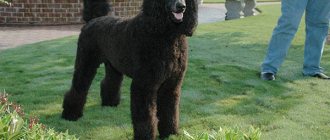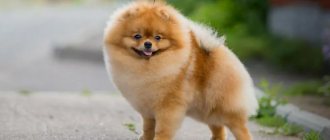In our article you will find a detailed story about how long representatives of this breed live, how to increase the lifespan of a pet with the help of proper care, and what kind of food to choose for it when it reaches old age. Read a useful article about what to feed a Chihuahua at home
Chihuahuas are small charming dogs, with doe eyes, fragile and so touching. When such a charmer comes into your home, you want her to live for a very long time and delight her with her presence. However, a dog's life is short and sooner or later a sad moment comes when you have to let your pet go to the rainbow. The owner of a tiny Chihuahua is concerned about how long these dogs live, how to care for them in order to prolong the dog’s life.
Lifespan of a Chihuahua
The main advantages of keeping small dogs are ease of transportation and moderate food costs. Quite a long life expectancy increases their rating as pets, preferable for keeping in an apartment. But for a dog to live a full and long life, effort must be made.
Despite their external fragility and vulnerability, nature has endowed the representatives of this breed with good health and endurance. Chihuahuas have a genetic predisposition to certain diseases that need to be addressed to avoid problems.
On average, Chihuahuas live 15–17 years, but for smaller varieties of dogs of this breed there are certain risks that reduce their lifespan.
Variety "standard"
The “standard” category includes Chihuahuas weighing from 1.5 to 3 kg. With proper care and feeding, these dogs live 14–15 years, but some individuals delight their owners with a longer lifespan. Standard Chihuahuas have been known to live up to 20 years.
The quality of life of a Chihuahua is affected by:
| Factor | Characteristic |
| Competent feeding | Dogs of this breed need a nutritious diet rich in animal proteins. Chihuahuas are energetic, love to move and play a lot, they need to compensate for their energy expenditure. When fed with industrial feed, they are given diets of at least super premium class and strictly follow the daily feeding standards. If the dog eats natural foods, the diet should be balanced: contain enough meat, all the necessary nutrients, minerals and vitamins |
| Health monitoring | Some hidden problems cannot be identified, so the dog must be taken to the veterinarian regularly |
| Family atmosphere | A nervous situation, quarrels between people, and exclusion of a dog from social circles have a negative impact on the mental and physical condition of the pet. Chihuahuas are emotional dogs that react sharply to what is happening. They have a stable psyche, but pets who constantly live in a state of stress and experience a lack of attention get sick more often than others, which affects their life expectancy |
| Timely vaccination and antiparasitic treatment | Timely vaccinations and prevention of worms, fleas and ticks reduce the risk of serious diseases and health problems. |
| Genetic predisposition | When buying a puppy, you should inquire about the health of the parents. Proper breeding involves reducing the influence of hereditary diseases from generation to generation. It is worth choosing a puppy from a kennel where breeders are focused not so much on making a profit, but on healthy offspring from their dogs |
| Active lifestyle | Keeping a Chihuahua at home does not mean a lack of daily walks. To develop immunity, maintain muscle tone and gain socialization skills, dogs require sufficient physical activity in the fresh air. |
The temperament of these dogs, their innate courage, natural curiosity and high mental abilities make it possible to teach Chihuahuas general rules of behavior and communication skills. This type of exercise is important for the dog’s health and affects its life expectancy.
We recommend
How many years do cats live: life expectancy table
Mini type
Chihuahuas weighing from 500 g to 1.8 kg are considered miniature. Such dogs live much shorter than their larger relatives - up to 10 years. All Chihuahuas have the same predisposition to diseases, but miniature breeds are at risk of death from injuries of varying severity due to careless handling.
The same requirements apply to the care and feeding of Chihuahuas of all varieties, but more careful supervision is required for the mini-pet, including:
- 1. Careful handling based on knowledge of the predisposition of animals to diseases of the musculoskeletal system. Mini dogs should not jump from heights or stand on their hind legs for a long time. Chihuahuas are very small, it happens that they get under the feet of their owners, and this leads to injuries and even death of the dogs.
- 2. Preparing younger family members for the arrival of a dog in the house. Children need to be explained that the Chihuahua is a fragile creature and requires careful treatment, not allowing rough play or carrying the puppy in your arms.
Miniature Chihuahuas are more susceptible to colds: this factor should be taken into account and protected from hypothermia.
Lifespan of the breed
Mini Chihuahua
Mini Chihuahuas are tiny representatives of the breed. They are smaller in size than standard, but larger than micro. Unfortunately, in the super-mini Chihuahua breed and in micro dogs, underdevelopment of one or another internal organ is very common. With age, this greatly affects the health of the animal. Therefore, the average lifespan of mini-sneezes does not exceed six years. Negative factors that make this figure even lower include genetic characteristics and lifestyle.
Standard view
On average, standard Chihuahuas live 15 years or more. Some dogs can live up to the age of twenty. In order for your pet to live as long as possible, timely detection of diseases and competent care are required. The advantage of standard Chihuahuas is their stronger immunity compared to their relatives.
What affects life expectancy
To ensure a long life for the dog, owners are required to familiarize themselves with the standard:
- Diet. It should be balanced and nutritious, without the addition of artificial colors or preservatives. It is not recommended to feed your pet leftover food. This will lead to poisoning, obesity of the Chihuahua and other harmful consequences.
- Genetics. If a dog has good genes, he will live a long time. Before purchasing a puppy, you need to carefully examine it and become familiar with its pedigree. Only healthy dogs will have good offspring.
- Lifestyle. Active Chihuahuas have a better chance of a long and prosperous existence. The owner must exercise the dog regularly. This leads to the burning of excess fat, strengthening the immune system and building muscle in the Chihuahua. The pet will also be less sick.
- Body mass. Some Chihuahua breeds are susceptible to certain disorders that reduce their lifespan. Weight should be average, otherwise weakening of the immune system cannot be avoided.
- Vaccination. It is required to prevent the development of a number of diseases in Chihuahuas that are life-threatening.
- Interaction. The animal must be under the constant care and care of its owner. It is not recommended to pick up the puppy, as there is a risk of damage to fragile limbs.
- Sterilization. Neutered pets live longer than regular dogs. The operation reduces the risk of developing cancer of the Chihuahua's genital organs. The level of aggression and rabies is also minimized.
- Visit doctor. The dog must undergo regular examinations at veterinary clinics. This will make it possible to promptly identify diseases in Chihuahuas in the early stages and promptly prevent their further development.
- Oral care. This breed is prone to dental problems. These include: gum inflammation, tooth decay and plaque. They shorten your pet's potential longevity as harmful bacteria travel through the bloodstream to vital organs.
- Conditions of detention. Dogs cannot tolerate low temperatures and copious amounts of moisture.
- Homely atmosphere. Pets are deprived of a stable psyche, so they react sharply to the manifestation of a nervous situation, quarrels and disagreements between people. Chihuahuas feel and perceive everything. Lack of contact causes a lack of love and attention from the owners.
The gender of the breed also affects their existence. Statistics have shown that female Chihuahuas live on average 2-3 years longer than males. At the moment, scientists have not identified the exact reasons for this result.
Causes of premature death of Chihuahuas
As noted above, life expectancy is partly influenced by the genetic characteristics of the animal. The Chihuahua breed is predisposed to a whole list of abnormalities and diseases that shorten life:
- diseases of the genitourinary system, in particular urolithiasis;
- hypoglycemia – decreased blood glucose levels;
- heart valve dysplasia;
- rheumatism and other joint diseases;
- diseases of the eyes, ears;
- dental problems, including caries, periodontal disease;
- difficult birth.
In addition, Chihuahuas (like other dog breeds) can easily become ill with the following infectious diseases, often leading to death:
- plague;
- rabies;
- leptospirosis;
- hepatitis.
Vaccination will help protect against the listed infections and other terrible diseases (for example, enteritis). Owners who refuse vaccinations often do not realize the consequences of such a decision. The first vaccine is given to puppies in infancy. During the quarantine period, the Chihuahua should not be allowed to come into contact with the outside world, especially with other animals.
Another reason for the premature departure of a Chihuahua is the owner’s elementary carelessness. This applies to a greater extent to children. A small child loves to cuddle and hug animals, but does not understand that this can be painful for a fragile miniature Chihuahua. For example, fractures may occur. And if you accidentally drop a sneeze, he is highly likely to get bruises or a concussion. In the worst case scenario, this will result in death.
A Chihuahua can also die from rat poisoning. Often he can find and eat it unnoticed while walking. Therefore, the owner is obliged to monitor the movement and actions of the animal. In addition, you need to accustom him to the command “Fu” or “No”. In general, any poisoning in principle is dangerous for sneezes. This condition quickly leads to exhaustion of the dog and his subsequent death.
Food for Chihuahua
To increase the pain-free life of a pet, owners must take into account the characteristics of the Chihuahua and its activity. The diet for the dog is built from these factors. It must contain the main components containing protein.
This is interesting: How to keep a Chihuahua in an apartment
Food:
ProductHow to serve
| Meat (horse meat, veal, chicken) | It can be offered to your pet no more than once a week in boiled form. In this case, you need to remove all the bones and peel so that the Chihuahua does not choke. |
| Fish | Prepared 2 times a week. The product must be steamed, without bones or fat. |
| Eggs | Serve once every 7 days alone or together with other ingredients. They need to be boiled or made into an omelette |
| Milk products | Milk products |
Expert opinion Anna Abramenko An avid dog lover. Experience in veterinary medicine since 2009. It is forbidden to feed your pet spicy, salty, sweet, sour or fried food. These foods provoke gastritis and rapid obesity in Chihuahuas. The main poison for dogs is walnuts. They disrupt metabolism, which causes bones to weaken and stones to form in your pet’s bladder.
Character and temperament
The Chihuahua is an active and fast dog with good reflexes. She is fearless and stands out for her stable psyche among other representatives of the dwarf breed. Chihuahuas do not throw tantrums, and there are practically no cowards among them. Chihuahuas are miniature warriors. They are curious, observant and know in advance where they are going to be taken: for a walk or for a friendly visit.
Since these babies are patient , they can sit and watch you work or do household chores for a long time, without disturbing or demanding attention. At the same time, you should know that they are not malicious and loyal , but very touchy and jealous . Any thoughtless cry can cause your pet to hide in its hiding place and nothing will force it to come out until the offense passes.
A Chihuahua will be able to get along with other dogs and other pets with ease if it feels like an unquestioning leader and the main object of adoration in the house.
For the same reason, you should not have it in a house where there are very young children. The dog does not understand children's pranks and will regard them as a threat. Therefore, despite its small size, it can scratch and even bite a child playing with it for self-defense.
When does a Chihuahua get old?
Dogs, like people, go through the following stages of life: childhood; youth; maturity; old age.
Dog handlers believe that a dog under the age of five months is considered a child. In the second six months of life, the dog goes through the difficulties of adolescence.
- In the second year, the dog reaches sexual maturity. The second year of life occurs in the dog's youth, and from two to eight years is the period of maturity.
A Chihuahua can be considered elderly after passing the eight-year mark. In this regard, it is necessary to change your walking routine and diet.
Everything is individual, and a dog that has lived to these years may remain active and lively, or may have a wide range of diseases and only a few teeth. The dog's health, the aging process, and much more are determined by lifestyle, proper care and, of course, genetics.
Caring for an older dog
As Chihuahuas age, they do not require complex changes in care. You should also take care of the coat, claws, teeth, eyes and ears.
The dog should be switched to age-appropriate dry food.
NOTE!
If feeding natural products, you will need to consult a specialist who will prescribe the necessary vitamin complex.
It is necessary to reconsider the walking regime - the dog should go outside, but the duration of the walk should be reduced.
Chihuahuas over 10 years of age must be checked for health twice a year..
Effect of castration
Castration is a type of surgical intervention during which the gonads of the testes in males and the ovaries in females are removed. After this, the production of sex hormones stops and the pet’s behavior changes. Both sexes lose interest in other dogs. The operation has no significant disadvantages. Main advantages:
- minimizing the development of cancers in the mammary glands and genital organs;
- reducing hair loss in dogs;
- preventing the occurrence of a hernia in the pet’s perineum;
- prevention for chronic ailments.
After the operation, females go into estrus, and males stop marking their territory. Animals become calm and do not experience excitement towards the opposite sex.
How long do they live in the private sector?
It is believed that in the private sector it is better to keep dogs that can spend a lot of time outside, guarding the yard. Tiny breeds are not suitable for such purposes. But still, some people get Chihuahuas to live in the house. If you provide normal living conditions for your pet in a private home, providing it with all the necessary conditions and safety, then life expectancy in the private sector will not differ from life expectancy in an apartment.
Diseases
The main ailments to which Chihuahuas are susceptible:
- eye diseases (cataracts, glaucoma, lens clouding, hypersensitivity);
- sudden seizures (seizures lead to loss of consciousness and epilepsy);
- damage to the oral cavity;
- weight loss;
- an increase in temperature above normal;
- vomit;
- dandruff;
- itching and burning;
- damage by small parasites;
- cough;
- loss of appetite or complete refusal to eat;
- intestinal disorders;
- purulent discharge from the ears and nose;
- rapid breathing. The appearance of these symptoms should concern the owner and prompt him to undergo a medical examination with the dog at a veterinary clinic. Only a specialist can make an accurate diagnosis and choose the right treatment.
How to extend life
In order to spend many years with their pet, Chihuahua owners should adhere to the following rules:
- Buy puppies only from trusted, reputable breeders to avoid congenital diseases.
- Visit your veterinarian regularly, starting when your pet is 6 months old.
- Get all required vaccinations on time.
- Deworm regularly and treat against ticks and fleas.
- Monitor the animal's diet. Eliminate unhealthy foods, do not give sweets, smoked foods, etc. The Chihuahua's menu should be completely balanced and contain the necessary vitamins and minerals. The breeder from whom you are buying the puppy or your veterinarian will help you choose ready-made special food or create a list of natural products.
- Take your pet for walks in the fresh air regularly . Provide moderate exercise and monitor your dog's activity.
- Constantly look after your pet, examine its ears, eyes, and nose. Particular attention should be paid to teeth.
- Take care of your dog's safety. Provide your pet with a warm, cozy place away from heating devices and drafts. Walk on a leash to avoid attacks from large dogs. Explain to children how to play with animals correctly, especially at an early age.
- Avoid overheating or hypothermia . In hot weather, walk in the shade, and in cold weather, wear special overalls.
- Protect your pet from stressful situations. To do this, he must be socialized from an early age.
Sterilization of pets also affects how long Chihuahua boys and girls live at home. This operation helps to avoid cancer of the reproductive organs.
We would be interested to know the opinion of long-living Chihuahua owners. What do you think has affected the lifespan of your pets? What advice on care and education could you give to those who would like to have such a baby? We are waiting for your recommendations.
Owner reviews
We got our Chihuahua from our sister. They got her as a toy for their daughter, but there was sorely not enough time to care for her. Since we were given a puppy, we had to train the baby to go potty and follow a daily routine. We feed her by the hour, about every 4 hours. She's used to it. He eats well, no problems with it. We feed Baby with special dry food and give him boiled water. We learned to go to the toilet while wearing a diaper in literally 2-3 days. She quickly realized how to behave.
We do not allow other people to touch or cuddle our Baby. She must know who is the master and who is the stranger. This must be taught for her own safety, so that no one poisons or steals her.
In winter, we move her house closer to the radiator, and also provided her with a blanket. Sometimes in the morning she jumps into our bed.
Of the whole family, she loves her husband most. I’m ready to sniff and lick him for hours. I also became friends with my son. Either he brings her toys, or she brings him toys. He loves to hide under the sofa and suddenly jump out from under it.
I recommend this breed to all lovers of small dogs, but do not forget that it requires care.
Julianna, Peter.
My mother loves cats, but I wanted a dog. I barely managed to persuade her to buy me a Chihuahua. I advise you to buy exclusively from specialized nurseries. I chose from puppies brought all the way from Belarus. We always joke about Businka about this, because she really loves potatoes.
A couple of years later, friends who work in a pet store offered me another Chihuahua for free. People bought it three times, but after some time they returned it. When I brought this dog-child to myself, I immediately saw that the unfortunate animal was being abused. She pressed herself to the floor when I raised my hand up to take something from the shelf and could even wet herself. But gradually we managed to calm her down and now she is a happy tiny dog named Pooh.
I want to say that when choosing a dog, check yourself to see if you can love and care for it. Yes, you are the master, but this does not give you the right to be aggressive. Only love, encouragement and “carrots” will help you train a wonderful and obedient pet.
Olga, Tyumen.
Simplified technique
The easiest way to calculate the age of a dog in relation to a person is to take 1 dog year as 7 human years. This technique spread in the middle of the 20th century at the suggestion of veterinarians, who proceeded from the simple ratio that a person lives on average 70 years, and a dog 10.
Due to its simplicity, this rule has become very widespread, but it does not take into account social aspects. A person is actually dependent on his parents for a quarter or even a third of his life - he does not create a family, studies, and learns the norms of morality and behavior in society.
The animal world cannot afford such luxury. So, a one-year-old pet approximately corresponds to 15 years of a person.
A one-year-old pet is already quite capable of performing its work functions.
Age by human standards
| Dog age | Person's age |
| 1 | 15 |
| 2 | 21 |
| 3 | 25 |
| 4 | 29 |
| 5 | 33 |
| 6 | 37 |
| 7 | 41 |
| 8 | 45 |
| 9 | 49 |
| 10 | 53 |
| 11 | 57 |
| 12 | 61 |
| 13 | 65 |
| 14 | 69 |
| 15 | 73 |
| 16 | 77 |
| 17 | 81 |
| 18 | 85 |
| 19 | 89 |
| 20 | 93 |
LeBeau theory
In 1953, the French veterinarian A. LeBeau, having examined the stages of growth and development of the body common to humans and animals, developed a theory that takes into account the accelerated development of a puppy at a young age. To do this, he compared:
- age of puberty;
- age of maturity;
- life expectancy.
According to this theory, the first year of a dog’s life is equal to 15 human years, a two-year-old individual corresponds to a 24-year-old person (i.e., the second year of its life is equal to 9 human years), and each subsequent year of life “adds” 4 human years to it.
LeBeau's theory does not take into account the developmental features of animals depending on their size.
Kleiber's Law
An attempt to link the correspondence of age with Kleiber’s well-known metabolic law of “three quarters” turned out to be untenable. Recall that Kleiber's law relates basal metabolic rate to body weight and predicts that larger animals should live longer.
In dogs, the relationship by breed is the opposite—small breeds live longer.
At the same time, the validity of Kleiber’s law is not questioned - the law works on warm-blooded animals ranging in size from a mouse to an elephant, and a dog “on average” occupies the place assigned to it by law on this scale.
The age ratio between a person and a dog will vary depending on the breed of the pet. So, 78 human years correspond to:
- 10 years of giant breeds;
- 12 years of large breeds;
- 14 years old medium breeds;
- 15-16 years of small breeds.
This inverse of the general dependence phenomenon within a species is observed in mice, horses and even in people, it is just more pronounced in dogs.
Accordingly, the general rule for the animal world that links life expectancy to heart rate does not work, according to which the heart of an animal makes 1 billion contractions during its life.
Small breeds have a faster heart rate, but they live longer. The weight of a mastiff (80 kg) is 40 times higher than the weight of a chihuahua (2 kg), and according to Kleiber’s law, it should live 2.5 times longer, but in fact it lives 1.5 times less.
The reason is most likely that the concentration of the insulin-like growth factor IGF-1, which, unlike growth hormone, is secreted throughout life and slows programmed cell death, is lower in small breeds than in large breeds. As a result, their aging slows down and the risks of age-related diseases are reduced.
Colors
The Chihuahua breed can be any color, with the exception of merle: dogs of this color are born with genetic diseases.
The pet's passport indicates one of 12 possible colors and their varieties.
White
Such dogs are snow-white, without spots or specks. The nose is black, brown or pink, and the rims of the lips and eyes are light.
33 breeds of white dogs.
Black
There are three varieties:
- Pure black. Completely black or with a small white spot on the chest. Snow-white paw tips are also allowed.
- Black and white. Against a dark background, light spots on the paws, chest, and tip of the tail stand out well. Markings of the same color on the neck and head are acceptable.
- White black. The main color is snow-white, with black spots on the body and/or head contrasting with it.
42 black dog breeds.
Blue
Pure blue color is also called diluted. Pets of this color are almost completely blue, not counting small light inclusions. The lobe, rim of the eyes and lips are gray.
Like the previous suit, blue has two subtypes: in combination with snow-white spots and white-blue.
Chocolate
With a purely chocolate color, the dog is all or almost completely brown. Varieties: chocolate with snow-white and white-chocolate.
Lilac
Another name is bleached brown. The coat is completely lilac (with possible snow-white spots), the nose, rims of the lips, and eyes are the same color.
There are also two varieties of this suit: lilac and white and white and lilac.
Sable
Sable colors include many types of colors and their varieties:
- Fawn with blackening. Sable with tan and dark tips of hair on the ears, head, back, tail. The nose, eye and lip rims are also black. There may be light marks on the fingers and on the chest. It is divided into two subspecies: with snow-white splashes and white-fawn with blackening.
- Red with blackening. Sable-red coloring with dark tips of hairs and possible snow-white spots. Nose, eyelids, lips - black. Like other colors, there are two subtypes: with white markings and white-red.
- Fawn with blue shading. Blue-fawn, with possible light markings. The ends of the hair, nose, lips, eyelids are gray. The varieties are the same: with light spots on a fawn background and white-fawn with blue shading.
- Red with blue shading. Combines red and blue-sable colors. The nose, lips, eyes are gray, the ends of the hair are bluish. Light spots on the paws and chest are allowed. Subspecies: with light markings and white-red with blue shading.
- Fawn with chocolate shading. The fawn color is combined with brown tips of the coat. The color of the nose, eyes, lips - in that darkening. Snow-white inclusions are allowed. This color also has two varieties: with light markings and white-fawn with chocolate shading.
- Red with chocolate shading. Similar to other sable colors, but the tips of the hair are colored red, and the lips, eyes, and nose are brown. There are also subspecies with light spots and white-red with chocolate darkening.
- Fawn with a lilac tint. The main color is fawn, and the tips of the hairs are colored purple. There are color combinations with light splashes or a white background with fawn-lilac spots.
Ginger
Like other colors, there are three types:
- Intense red. Pure red without darkening.
- Red with white spots. Light areas are clearly visible on the red background.
- White and red. The white coat is decorated with pure red markings on the head or body.
40 breeds of dogs with red color.
Pale yellow
Pure fawn color is characterized by a light red coat color without darkening. There may be light spots on the chest and paws.
Subspecies are also distinguished: fawn with light splashes and white-fawn.
Cream
It is also called highly bleached red. With this color, the coat is cream-colored. As in other colors, lightened markings on the paws and chest are allowed.
The varieties are the same: with light markings and white-cream.
Tan
There are four main types and their varieties in this color.
- Black and tan. Pure black with tan and possible snow-white splashes on the chest and tips of the paws. Subspecies: with light markings and tricolor with a predominant white background (more than 50%).
- Chocolate and tan. It also exists in three varieties: pure chocolate and tan, with snow-white spots and tri-color.
- Blue and tan. Clean, with white markings and tricolor.
- Lilac and tan. The lilac background is combined with light red tan. The subspecies are the same: with snow-white spots and tricolor.
brindle
Rare and interesting color. On a fawn or red background there are alternating vertical stripes of any size. They can be rare or so frequent that they almost completely hide the main suit.
With brindle color, the stripes are eumelanin, i.e. dark shades: black, chocolate, blue, lilac, red.
Maroon
Also an unusual color. The main color of the fur coat is white. It is complemented by small spots (speckles) of various sizes and in any quantity. Their color must match the color of the dog.











